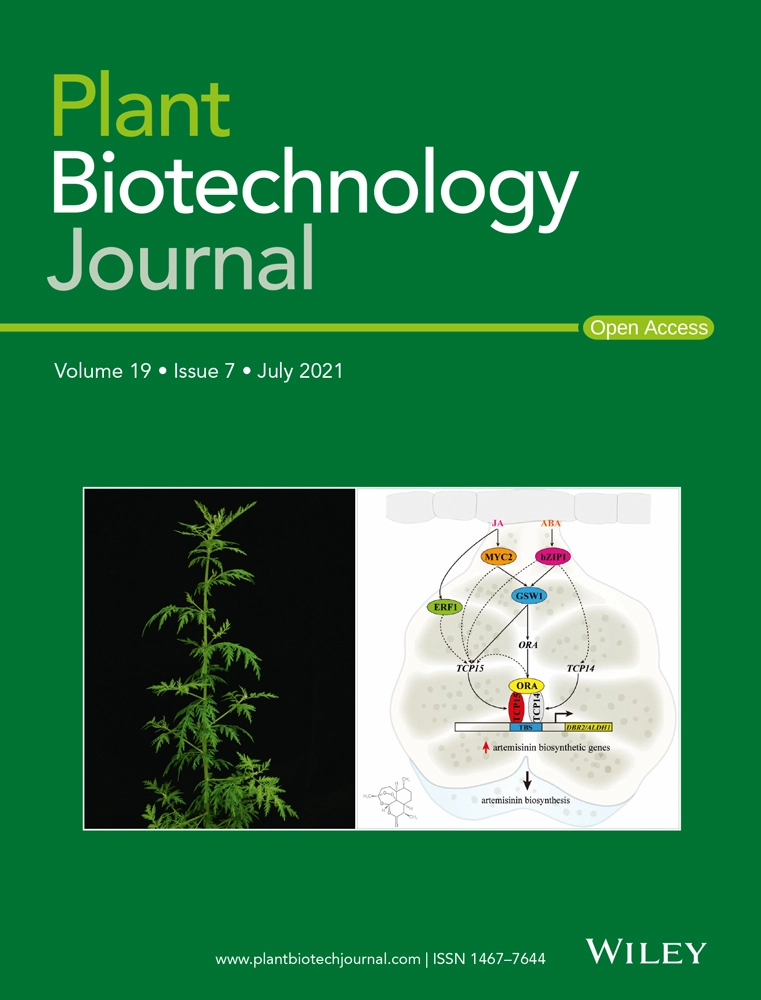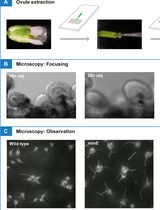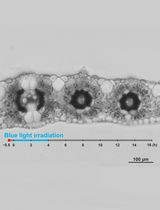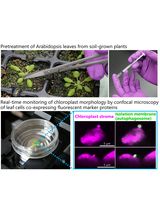- EN - English
- CN - 中文
Synthetic Promoter Screening Using Poplar Mesophyll Protoplast Transformation
用杨树叶肉原生质体转化进行合成启动子筛选
发布: 2023年04月20日第13卷第8期 DOI: 10.21769/BioProtoc.4660 浏览次数: 1855
评审: Pooja VermaAnonymous reviewer(s)
Abstract
Plant protoplasts are useful to study both transcriptional regulation and protein subcellular localization in rapid screens. Protoplast transformation can be used in automated platforms for design-build-test cycles of plant promoters, including synthetic promoters. A notable application of protoplasts comes from recent successes in dissecting synthetic promoter activity with poplar mesophyll protoplasts. For this purpose, we constructed plasmids with TurboGFP driven by a synthetic promoter together with TurboRFP constitutively controlled by a 35S promoter, to monitor transformation efficiency, allowing versatile screening of high numbers of cells by monitoring green fluorescent protein expression in transformed protoplasts. Herein, we introduce a protocol for poplar mesophyll protoplast isolation followed by protoplast transformation and image analysis for the selection of valuable synthetic promoters.
Graphical overview

Background
Transient transformation assays using plant protoplasts are effectively used for rapid evaluation of the subcellular localization of interesting proteins and how promoters regulate transcription, a lengthy process in stably engineered plants. In many cases, protoplasts are suitable proxies for the plant tissues used to isolate protoplasts—from physiological and molecular events to those in a whole organism. Therefore, protoplasts may be useful to investigate hormone responses, metabolomic processes, and cell responses against abiotic or biotic cues with minimal effort. Protoplasts provide a versatile plant cell system for screening many DNA fragments, which can be broadly applied in synthetic biology techniques. Especially, protoplast transformation can be effectively applied to determine synthetic promoter function using assays of induced marker genes (Cai et al., 2020; Jores et al., 2021; Yang et al., 2021). Furthermore, recent successes in rapid screening CRISPR/Cas9 constructs for gene edition after protoplast transformation show another application for protoplasts in synthetic biology (Lin et al., 2018; Toda et al., 2019; Rather et al., 2022). Additionally, with the recent appearance of practical methods for single cell–based -omics research using protoplasts (Chen et al., 2021; Farmer et al., 2021; Liu et al., 2021; Seyfferth et al., 2021; Liu et al., 2022; Mo and Jiao, 2022), the potential applications are continuing to grow in advanced research fields.
To date, plant protoplast transformation has been achieved in various herbaceous species as well as woody plants, since the initial methods were devised using Arabidopsis leaves (Yoo et al., 2007). Among them, poplar has been an attractive application for accelerating research in biofuel and bioproducts. Poplar protoplast isolation has been established using leaf mesophyll and stem tissues (Guo et al., 2012; Lin et al., 2014; Chen et al., 2021). A practical application for determining valuable stress-responsive synthetic promoters was successfully applied with poplar mesophyll protoplast transformation followed by fluorescence image analysis (Yang et al., 2021). The present protocol introduces the isolation of poplar mesophyll protoplasts to be applied for synthetic promoter assays by image analysis through fluorescence detection. This protocol uses less cell wall digestion enzyme and yields higher protoplast recovery compared to a regular poplar mesophyll protoplast preparation. Furthermore, a simpler and more convenient method using fluorescence measurement is utilized for the synthetic promoter screening.
Materials and Reagents
INRA 717-1B4 (Populus tremula × Populus alba) hybrid poplar
Glass plate
Single edge blades (Personna, catalog number: 94-120-71)
100 mm diameter and 20 mm deep Petri dishes (Fisher Scientific, catalog number: FB087511Z)
Magenta GA-7 plant culture box (Fisher Scientific, catalog number: 50-255-176)
BasixTM polystyrene serological pipette 10 mL (Thermo Scientific, catalog number: 14-955-234)
50 mL tube (Thermo Scientific, catalog number: 339650)
0.45 µm filter (Millipore, catalog number: SLHV004SL)
Round bottom disposable glass culture tube (10 mL) (Fisher Scientific, catalog number: 14-961-27)
96-well black/clear bottom plate (Thermo Scientific, catalog number: 165305)
40 µm sterile cell strainers (Fisher Scientific, catalog number: 08-771-1)
Murashige and Skoog (MS) basal salts with macronutrients and micronutrients (Caisson Labs, catalog number: MSP01)
MS vitamin solution (Caisson Labs, catalog number: MLV01)
MES hydrate (Thermo Scientific, catalog number: H5672.36)
KOH (Fisher Scientific, catalog number: M1064621000)
Sucrose (Fisher Scientific, catalog number: AA36508A1)
Activated charcoal (Sigma-Aldrich, catalog number: C9157)
GelzanTM CM (Gelrite®, Sigma-Aldrich, catalog number: G1910)
Indole-3-butyric acid (IBA) (PhytoTech Labs, catalog number: 1358)
Cellulase OnozukaTM R-10 (Yakurut Co., Cellulase OnozukaTM R-10)
MacerozymeTM R-10 (Yakurut Co., MacerozymeTM R-10)
D-mannitol (Sigma-Aldrich, catalog number: M4125)
KCl (Sigma-Aldrich, catalog number: P3911)
CaCl2 (Sigma-Aldrich, catalog number: C4901)
NaCl (Fisher Scientific, catalog number: BP358)
MgCl2 (Fisher Scientific, catalog number: AC223211000)
Bovine serum albumin (BSA) (Sigma-Aldrich, catalog number: A2153)
Polyethylene glycol M.W. 6000 (PEG) (Sigma-Aldrich, catalog number: 81260)
Deionized-distilled water (ddH2O)
Rooting media (see Recipes)
Cell wall degradation enzyme mixture (see Recipes)
W5 solution (see Recipes)
MMg solution (see Recipes)
40% PEG solution (see Recipes)
WI solution (see Recipes)
Equipment
Growth chamber (Percival, model: CU-36L4)
Hausser ScientificTM 3200 hemacytometer (Fisher Scientific, catalog number: 02-671-54)
Micropipette sets 0.5–10 µL, 10–100 μL, and 100–1,000 µL (Corning, catalog numbers: 4071, 4073, 4075)
Micropipette tips 0.1–10 µL, 5–300 µL, and 100–1,000 µL (Fisher Scientific, catalog numbers: 02-707-454, 02-707-447, 02-707-408)
Water bath (Fisher Scientific, model: IsoTEMP 105)
Vacuum chamber (BVV, model: GV3G)
Orbital shaker (Lab-Line, model: 3520)
Centrifuge (Thermo Scientific, model: SorvallTM RC 6+) with swinging buckets (SH3000)
EVOS M7000 imaging system (Invitrogen, model: AMF7000)
Software
ImageJ (National Institutes of Health, imagej.nih.gov)
Procedure
文章信息
版权信息
© 2023 The Author(s); This is an open access article under the CC BY-NC license (https://creativecommons.org/licenses/by-nc/4.0/).
如何引用
Yang, Y., Shao, Y., Chaffin, T. A., Ahkami, A. H., Blumwald, E. and Stewart Jr., C. N. (2023). Synthetic Promoter Screening Using Poplar Mesophyll Protoplast Transformation. Bio-protocol 13(8): e4660. DOI: 10.21769/BioProtoc.4660.
分类
生物工程 > 合成生物学
植物科学 > 植物细胞生物学 > 细胞成像
生物科学 > 生物技术
您对这篇实验方法有问题吗?
在此处发布您的问题,我们将邀请本文作者来回答。同时,我们会将您的问题发布到Bio-protocol Exchange,以便寻求社区成员的帮助。
Share
Bluesky
X
Copy link













